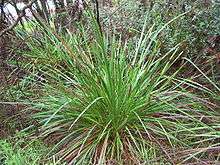Lepidosperma gladiatum
| Lepidosperma gladiatum | |
|---|---|
 | |
| Scientific classification | |
| Kingdom: | Plantae |
| (unranked): | Angiosperms |
| (unranked): | Monocots |
| (unranked): | Commelinids |
| Order: | Poales |
| Family: | Cyperaceae |
| Genus: | Lepidosperma |
| Species: | L. gladiatum |
| Binomial name | |
| Lepidosperma gladiatum Labill. | |
Lepidosperma gladiatum is commonly known as the coast sword-sedge or coastal sword-sedge. It is an evergreen species of sedge that is native to southern coastal areas of Australia.[1] It was described by French botanist Jacques Labillardière in 1805.
Distribution and habitat
L. gladiatum in coastal regions around Australia in the States of New South Wales, Victoria, Tasmania, South Australia and Western Australia. In Western Australia it can be found as far north as Cervantes and as far east as Cape Arid National Park.[2]
L. gladiatum occurs mostly as a dense sedge that favours dunes and creek lines. Described as clump-forming perennial with stout vertical rhizome. Forms dense canopy with large clumps of dark green strap-like leaves. The flat leaves are 150m long and 25mm wide with a sharp pointed end. The plant can be as tall and wide as 3m (though typically it is smaller).[3]
L. gladiatum produces brown spiky flowers on long central stalks flowers are hermaphroditic.[4]
References
- ↑ "PlantNET - NSW Flora Online". 2007. Retrieved June 6, 2007.
- ↑ "Florabase WA - Lepidosperma gladiatum". 2007. Retrieved June 6, 2007.
- ↑ "WA Plants - Cyperaceae". 2007. Retrieved June 6, 2007.
- ↑ "Plants ForA Future - Lepidosperma gladiatum". 2007. Retrieved June 6, 2007.